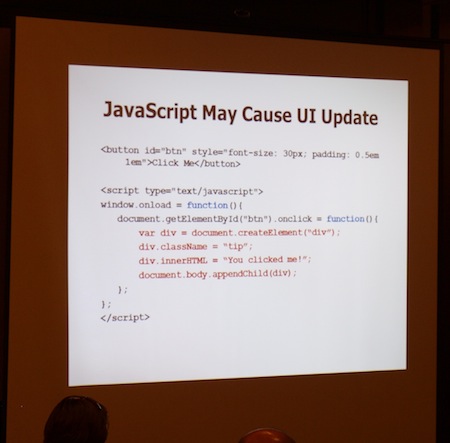This non-developer probably won’t be using any of the deep JavaScript knowledge that was being radiated by the speakers at the CapitolJS conference held in Washington yesterday.
Still I was very have glad to have been there, immersed in the hacker karma: the spirit of sharing JavaScript wisdom was definitely present.
And it was also great to finally meet Voxeo’s Mark Headd, my sponsor for this event. The MLB scores Phono app, which I’ve blogged about had, ahem, won a contest, and was my ticket to this gathering. Oh, I also learned there’ll be some good news about Voxeo’s Phono shortly. I’ll keep you posted.
For those who didn’t make it, I have some cool links below and a JavaScript tip or two to entice you to read on.
As just about everyone has figured out, HTML5 and JavaScript is an efficient way to craft amazingly powerful apps that run on different devices. Earlier this summer, I had a chance to see what’s coming at the DevCon5 conference, which was devoted to those two technologies. So really understanding JS is crucial to the success of your next great idea.
<aside>So important is JS knowledge that probably a few angel investor types—David S Rose, you are excused— who judge at these pitch events in NYC should make a half-hearted attempt to grok this new movement towards less-thin JS client software. At least enough so that their slightly technical queries can pass a giggle test </aside>.

Shocking! There was a code on the screen.
For your edification, here’s a small taste of what the conference was like.
Want to develop high-performance JavaScript code?
For that Nicholas Zakas is the go-to person, having written the book literally (see below) on this subject. In his presentation, he dispensed sagely advice on how to avoid browser hiccups as JS libraries are downloaded.
Zakas’s solutions use advanced techniques involving clever DOM programming or exploiting the outer corners of the JavaScript universe with <script async> and <script defer> tags.
And when JS is executing, of course the browser UI is not. With more complex code running on devices these days, you need a way to defer app processing and not hog the CPU. Check out Zakas’s slides for some of his code ideas.
Add by all means, view this interesting demo (only available on IE), which shows the power of the new setImmediate function. If you thought you understood setTimeout, you probably don’t!
Have your eyes glazed over? If you’ve followed me this far, then I can tell you these speakers were masters of their material and made their talks compelling—sorry to lapse into a marketingism, but it’s true—and completely relevant.
Wait, there’s more. Even I’ve run into the dreaded cross-domain problem in my modest JavaScript efforts. There’s are several ways to get around this, and Alex Sexton was the man to explain this. Wow, I didn’t know that a pretty standard trick was to use iFrames to pull in data from a different source, but Alex took that concept to the next level and beyond.
Presented by Rebecca Murphey, Mulberry is something like a framework for quickly baking mobile JS apps. It also works with the amazing PhoneGap, an HTML5 platform that I actually heard about before the conference. I am impressed, intrigued, and perhaps a little motivated to experiment with Mulberry.
I can’t end this post without mentioning Jed Schmidt and his 140byte.es community. Tweet-sized, 140 byte JavaScript functions are insanely clever, quirky, and ironic all at the same time. Fork and contribute!
Related articles
- CapitolJS
- Nicholas Zakas’s slide deck on High Performance JavaScript (slideshare.net)
- Nicholas Zakas’s web site
- High Performance JavaScript (oreilly.com)
- Alex Sexon’s web site
- Toura Mulberry
- Rebecca Murphey’s blog
- 140byte.es
- Summer Fun: Baseball and Phono (technoverseblog.com)


